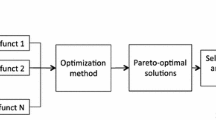Abstract
In this paper, the automatic segmentation of a multispectral magnetic resonance image of the brain is posed as a clustering problem in the intensity space. The automatic clustering problem is thereafter modelled as solving a multiobjective optimization (MOO) problem, optimizing a set of cluster validity indices simultaneously. A multiobjective clustering technique, named MCMOClust, is used to solve this problem. MCMOClust utilizes a recently developed simulated annealing based multiobjective optimization method as the underlying optimization strategy. Each cluster is divided into several small hyperspherical subclusters and the centers of all these small sub-clusters are encoded in a string to represent the whole clustering. For assigning points to different clusters, these local sub-clusters are considered individually. For the purpose of objective function evaluation, these sub-clusters are merged appropriately to form a variable number of global clusters. Two cluster validity indices, one based on the Euclidean distance, XB-index, and another recently developed point symmetry distance based cluster validity index, Sym-index, are optimized simultaneously to automatically evolve the appropriate number of clusters present in MR brain images. A semi-supervised method is used to select a single solution from the final Pareto optimal front of MCMOClust. The present method is applied on several simulated T1-weighted, T2-weighted and proton density normal and MS lesion magnetic resonance brain images. Superiority of the present method over Fuzzy C-means, Expectation Maximization clustering algorithms and a newly developed symmetry based fuzzy genetic clustering technique (Fuzzy-VGAPS), are demonstrated quantitatively. The automatic segmentation obtained by multiseed based multiobjective clustering technique (MCMOClust) is also compared with the available ground truth information.
Similar content being viewed by others
References
Gonzalez RC, Woods RE (1992) Digital image processing. Addison-Wesley, Reading
Suckling J, Sigmundsson T, Greenwood K, Bullmore E (1999) A modified fuzzy clustering algorithm for operator independent brain tissue classification of dual echo MR images. Magnetic Resonance Imaging 17:1065–1076
Bhandarkar SM, Zhang H (1999) Image segmentation using evolutionary computation. IEEE Trans Evol Comput 3(1):1–21
Saha S, Bandyopadhyay S (2007) MRI brain image segmentation by fuzzy symmetry based genetic clustering technique. In: Proceedings of the 2007 IEEE congress on evolutionary computation (CEC’07), pp 4417–4424
Cordón O, Damas S, Santamaría J, Martí R (2008) Scatter search for the point-matching problem in 3d image registration. INFORMS J Comput 20(1):55–68
Saha S, Bandyopadhyay S (2009) MR brain image segmentation using a multi-seed based automatic clustering technique. Fund Inform 97(1–2):199–214
Bandyopadhyay S, Saha S (2008) A point symmetry based clustering technique for automatic evolution of clusters. IEEE Trans Knowl Data Eng 20(11):1–17
Saha S, Bandyopadhyay S (2008) Application of a new symmetry based cluster validity index for satellite image segmentation. IEEE Geosci Remote Sens Lett 5(2):166–170
Deb K (2001) Multi-objective optimization using evolutionary algorithms. Wiley, New York
Bandyopadhyay S, Saha S, Maulik U, Deb K (2008) A simulated annealing based multi-objective optimization algorithm: AMOSA. IEEE Trans Evol Comput 12(3):269–283
Bandyopadhyay S, Saha S (2010) A generalized automatic clustering algorithm in a multiobjective framework. Patern Recognit (communicated)
Xie XL, Beni G (1991) A validity measure for fuzzy clustering. IEEE Trans Pattern Anal Mach Intell 13:841–847
Bezdek JC (1981) Pattern recognition with fuzzy objective function algorithms. Plenum, New York
Jain AK, Murty MN, Flynn PJ (1999) Data clustering: a review. ACM Comput Surv 31(3):264–323
Metropolis N, Rosenbluth AW, Rosenbloth MN, Teller AH, Teller E (1953) Equation of state calculation by fast computing machines. J Chem Phys 21(6):1087–1092
Geman S, Geman D (1984) Stochastic relaxation, Gibbs distributions and the Bayesian restoration of images. IEEE Trans Pattern Anal Mach Intell 6(6):721–741
Bandyopadhyay S, Saha S (2007) GAPS: A clustering method using a new point symmetry based distance measure. Pattern Recognit 40:3430–3451
Everitt BS (1993) Cluster analysis, 3rd edn. Halsted Press, New York
Ben-Hur A, Guyon I (2003) Detecting stable clusters using principal component analysis in methods in molecular biology. Humana Press, Clifton
Luque JM, Santana-Quintero LV, Hernández-Díaz AG, Coello CAC, Caballero R (2009) g-dominance: Reference point based dominance for multiobjective metaheuristics. Eur J Oper Res 197(2):685–692
BrainWeb: Simulated brain database. Available: http://www.bic.mni.mcgill.ca/brainweb
Cocosco CA, Kollokian V, Kwan RKS, Pike GB, Evans AC (1997) Brainweb: Online interface to a 3d MRI simulated brain database. NeuroImage 5:425
Kwan RS, Evans A, Pike G (1999) MRI simulation-based evaluation of image-processing and classification methods. IEEE Trans Med Imaging 18(11):1085–1097
Kwan RKS, Evans AC, Pike GB (1996) An extensible MRI simulator for post-processing evaluation. In: VBC’96: Proceedings of the 4th international conference on visualization in biomedical computing. Springer, London, pp 135–140
Collins DL, Zijdenbos AP, Kollokian V, Sled JG, Kabani NJ, Holmes CJ, Evans AC (1998) Design and construction of a realistic digital brain phantom. IEEE Trans Med Imaging 17(3):463–468
Bandyopadhyay S, Pal SK, Aruna B (2004) Multi-objective GAs, quantitative indices and pattern classification. IEEE Trans Syst Man Cybern B 34(5):2088–2099
Author information
Authors and Affiliations
Corresponding author
Rights and permissions
About this article
Cite this article
Saha, S., Bandyopadhyay, S. Automatic MR brain image segmentation using a multiseed based multiobjective clustering approach. Appl Intell 35, 411–427 (2011). https://doi.org/10.1007/s10489-010-0231-6
Published:
Issue Date:
DOI: https://doi.org/10.1007/s10489-010-0231-6




